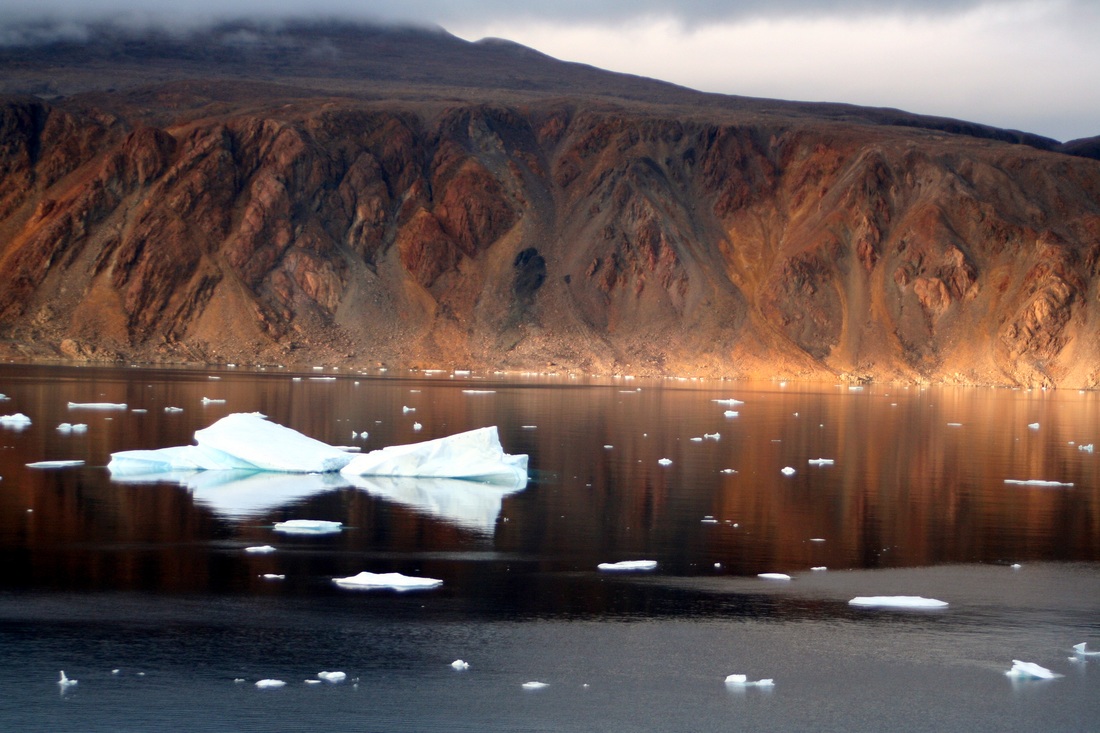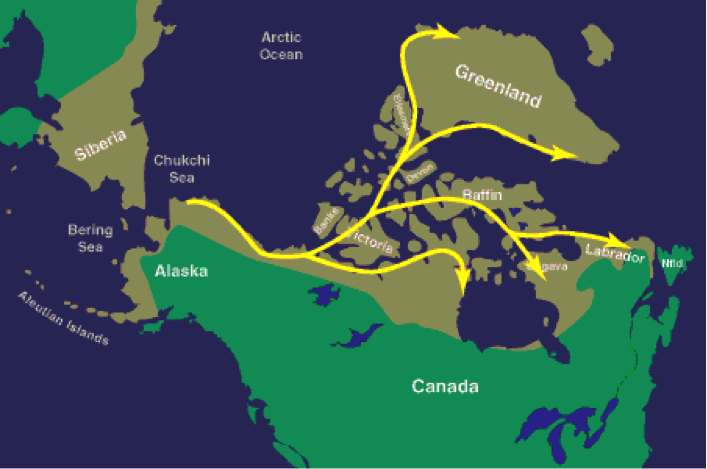|
Dr. Bathsheba Demuth, Brown University. The Greenlandic coast. Source: TheBrockenInaGlory, Wikimedia Commons, 2005, commons.wikimedia.org/wiki/File:Greenland_coast.JPG In the year 1001 CE, Leif Erikson made landfall in Greenland, and traded with people who “in their purchases preferred red cloth; in exchange they had furs to give.” The Vikings called these people Skraelings. Present-day archeologists and historians call them the Thule. At its height, Thule civilization spread from its origins along the Bering Strait across the Canadian Arctic and into to Greenland. The ancestors of today’s Inuit and Inupiat, the Thule accomplished what Erikson and subsequent generations of Europeans never managed: living in the high Arctic without supplies of food, technology, and fuel from more temperate climates. The Thule left archeological evidence of a technologically sophisticated, vigorous people. They invented the umiak, an open walrus-hide boat so large that it was sometimes equipped with a sail. These boats, when used alongside small, nimble kayaks, made the Thule formidable marine-mammal hunters. On land, they harnessed dogs to sleds and built homes half-underground, insulated by earth and beamed with whale bones. People did inhabit the high North American Arctic before the Thule. Their immediate predecessors, called the Dorset by archeologists, were expert carvers, and there are signs of other cultures that date back at least five thousand years. But the Thule appear to have been a particularly robust society, one that inhabited thousands of challenging Arctic miles. Eventually, they even traded with Europeans for metal tools, sending walrus ivory as far abroad as Venice. Thule migration routes from the Bering Strait east. Map credit: anthropology.uwaterloo.ca/ArcticArchStuff In the twentieth century, many archeologists linked the success of the Thule to the climate. In this view, rapid Thule expansion coincided with the Medieval Warm Period in the years between 1000 and 1300. The Thule were expert whalers, especially of bowhead whales. This slow species makes for good prey. Their 100-ton bodies can be fifty percent fat by volume, giving people ample calories to eat and burn through long winters. With the slight increase in temperature during the Medieval Warm Period, the theory went, the range of the bowhead whale expanded across newly ice-free waters. Atlantic and Pacific bowhead populations eventually met in the Arctic Ocean north of Canada, offering an uninterrupted banquet of blubber to hunters. The Thule, in this view, were simply whale hunters who followed the migration of their prey in a warming climate. Environmental conditions, not a sophisticated culture, was the key explanation for their success. Emphasizing climate as the cause of migration and social success reduced the achievements of the Thule, essentially, to those of their prey. However, twenty-first century evidence is changing this account of Thule migration. In 2000, Robert McGhee questioned the validity of the radiocarbon dates that helped establish Thule expansion as an eleventh-century phenomenon. He proposed the 1200s as the earliest date of migration. Then, genetic tests by marine biologists showed that Atlantic and Pacific bowhead whales did not mix their populations during the Medieval Warm Period, meaning that there was a substantial gap in whaling possibilities on the Arctic coast. Something more complicated than just following the blubber drove the Thule eastward. McGhee speculated that communities moved for iron, which is short supply in the Arctic. Thule hunters learned from the Dorset people of a deposit left by the Cape York meteorite. They colonized huge territories to secure their access to this precious resource from outer space. Other specialists theorized that population pressure, overhunting, or warfare led the Thule to migrate east. Thule archeological site, with whalebone beams among flooring stones. Photo credit: anthropology.uwaterloo.ca/ArcticArchStuf The ongoing work of Canadian archeologists T. Max Friesen and Charles D. Arnold seems to confirm that we must look beyond simple climatic explanations for the Thule expansion. Working on Beaufort Sea and Amundsen Gulf sites, the pair established that there was no definitive Thule occupation in this part of the western Arctic prior to the thirteenth century. Because any Thule migrants would have had to pass through these points as they moved east, their research indicates that the Thule civilization was only beginning its continental spread around the year 1200, well into the period of warming. The climate may have helped the Thule quickly spread toward Greenland, but the onset of the Medieval Warm Period did not automatically draw people eastward.
Moreover, the work of other archeologists on the Melville Peninsula, along Baffin Bay, indicates that the Mediaeval Warm Period was not always so warm. Some areas of the Arctic saw slight temperature increases, but in general the millennium was cooler than those past. In places, the effects of the so-called Little Ice Age began a century or two before they were evident across the globe, meaning the Thule adapted not to a warmer Arctic, but a colder one. This cooling was more apparent in the west, where the team found fewer Thule sites but also more stability, both in the climate and the record of human occupation. To the east of the Melville Peninsula, where temperatures did warm, the climate was also more variable – adding a new set of complexities to social and economic life. The move into the central Arctic, therefore, reflected forces other than climate. Beginning in the fifteenth century, Thule culture fragmented, specialized, and emerged eventually as distinct contemporary Inuit and Inupiat groups. The Little Ice Age is often the reason given for the disintegration of Thule civilization in the fifteenth century. Yet, the work by Finkelstein, Ross, and Adams indicates that, while the Thule abandoned some sites due to cooling trends, this did not hold in all cases. Other causes, including increased contact with Europeans and their infectious diseases, might have had more to do with the disintegration in some locations. Overall, the new vision of the Thule prominence in the Arctic makes their rise shorter, but even more impressive. And if the Thule began their migration only in 1200, it seems unlikely they spread east simply to find iron. This would have required only smaller-scale movements to precise locations. Instead, the Thule developed a thriving, intricate network of settlements across the Arctic. For Friesen and Arnold, this is evidence that the Thule expanded in order to recreate the ideological and economic lives that they had enjoyed in their origins along the Bering Strait. And in just a century they did, not only by inhabiting land from the Bering Strait to Greenland, but through explorations to the northern edges of the continent. All of this also helps us reinterpret a well-known tale from the Viking exploration of the Arctic. When Leif Erikson’s sister Freydis frightened off a band of Skraelingar in the early eleventh century by striking “her breast with the naked sword” of a fallen Viking, she was likely not fighting the Thule, as scholars have assumed. Perhaps it was the Dorset people that “were frightened, and rushed off in their boats.” The Thule, at least, were likely still a century away from the eastern Canadian coastline. They were not easily daunted either by a shifting climate or by Viking weapons. References Quotes from the Saga of Erik the Red, English translation by J. Sephton, can be found here: http://www.sagadb.org/eiriks_saga_rauda.en Friesen, T. Max and Charles D. Arnold. “The Timing of the Thule Migration: New Dates from the Western Canadian Arctic,” American Antiquity 73 (2008): 527-538. Finkelstein, S.A., J.M Ross, and J.K Adams. “Spatiotemporal Variability in Arctic Climates of the Past Millennium: Implications for the Study of Thule Culture on Melville Peninsula, Nunavut,” Arctic Antarctic, and Apline Research 41 (200): 442-454. McGhee, Robert. “Radio Carbon Dating and the Timing of the Thule Migration,” in Appelit, M. Berglund, J, and Gullov, H.C. eds. Identities and Cultural Contacts in The Arctic: Proceedings from a Conference at the Danish National Museum. Copenhagen (2000): 181-191. Morrison, David. “The Earliest Thule Migration.” Canadian Journal of Archaeology 22( 1999): 139-156. Betts, Matthew, and T. Max Friesen, “Quantifying Hunter-Gatherer Intensification: A Zooarchaeological Case Study form Arctic Canada,” Journal of Anthropological Archaeology 23 (2004): 357-384. Dyke, Arthur S., James Hooper, and James M. Savelle. “A History of Sea Ice in the Canadian Arctic Archipelago based on Postglacial Remains of the Bowhead Whale (Balaena mysticetus)”, Arctic 49 (1996): 235-255. Park, Robert W. “The Dorset-Thule Succession Revisited,” in Appelit, M. Berglund, J, and Gullov, H.C. eds. Identities and Cultural Contacts in the Arctic: Proceedings from a Conference at the Danish National Museum. Copenhagen (2000): 192-205. |
Archives
March 2022
Categories
All
|




 RSS Feed
RSS Feed